[English] 日本語
 Yorodumi
Yorodumi- PDB-4x9r: PLK-1 polo-box domain in complex with Bioactive Imidazolium-conta... -
+ Open data
Open data
- Basic information
Basic information
| Entry | Database: PDB / ID: 4x9r | |||||||||||||||
|---|---|---|---|---|---|---|---|---|---|---|---|---|---|---|---|---|
| Title | PLK-1 polo-box domain in complex with Bioactive Imidazolium-containing phosphopeptide macrocycle 3B | |||||||||||||||
 Components Components |
| |||||||||||||||
 Keywords Keywords | TRANSFERASE/TRANSFERASE INHIBITOR / POLO BOX DOMAIN PHOSPHOPEPTIDE MACROCYCLE INHIBITOR COMPLEX / TRANSFERASE-TRANSFERASE INHIBITOR complex | |||||||||||||||
| Function / homology |  Function and homology information Function and homology informationMitotic Telophase/Cytokinesis / regulation of protein localization to cell cortex / Mitotic Metaphase/Anaphase Transition / synaptonemal complex disassembly / Activation of NIMA Kinases NEK9, NEK6, NEK7 / polo kinase / mitotic nuclear membrane disassembly / homologous chromosome segregation / protein localization to nuclear envelope / Phosphorylation of Emi1 ...Mitotic Telophase/Cytokinesis / regulation of protein localization to cell cortex / Mitotic Metaphase/Anaphase Transition / synaptonemal complex disassembly / Activation of NIMA Kinases NEK9, NEK6, NEK7 / polo kinase / mitotic nuclear membrane disassembly / homologous chromosome segregation / protein localization to nuclear envelope / Phosphorylation of Emi1 / metaphase/anaphase transition of mitotic cell cycle / female meiosis chromosome segregation / nuclear membrane disassembly / synaptonemal complex / Phosphorylation of the APC/C / anaphase-promoting complex binding / Golgi inheritance / outer kinetochore / positive regulation of ubiquitin protein ligase activity / microtubule bundle formation / double-strand break repair via alternative nonhomologous end joining / mitotic chromosome condensation / Polo-like kinase mediated events / Golgi Cisternae Pericentriolar Stack Reorganization / regulation of mitotic spindle assembly / centrosome cycle / positive regulation of ubiquitin-protein transferase activity / regulation of mitotic metaphase/anaphase transition / regulation of mitotic cell cycle phase transition / sister chromatid cohesion / mitotic spindle assembly checkpoint signaling / mitotic spindle pole / spindle midzone / mitotic G2 DNA damage checkpoint signaling / regulation of anaphase-promoting complex-dependent catabolic process / establishment of mitotic spindle orientation / mitotic sister chromatid segregation / mitotic cytokinesis / positive regulation of proteolysis / negative regulation of double-strand break repair via homologous recombination / Regulation of MITF-M-dependent genes involved in cell cycle and proliferation / Cyclin A/B1/B2 associated events during G2/M transition / protein localization to chromatin / Amplification of signal from unattached kinetochores via a MAD2 inhibitory signal / Mitotic Prometaphase / EML4 and NUDC in mitotic spindle formation / Loss of Nlp from mitotic centrosomes / Loss of proteins required for interphase microtubule organization from the centrosome / centriole / Recruitment of mitotic centrosome proteins and complexes / Recruitment of NuMA to mitotic centrosomes / Anchoring of the basal body to the plasma membrane / regulation of mitotic cell cycle / Resolution of Sister Chromatid Cohesion / AURKA Activation by TPX2 / Condensation of Prophase Chromosomes / mitotic spindle organization / regulation of cytokinesis / establishment of protein localization / RHO GTPases Activate Formins / APC/C:Cdh1 mediated degradation of Cdc20 and other APC/C:Cdh1 targeted proteins in late mitosis/early G1 / peptidyl-serine phosphorylation / protein destabilization / kinetochore / positive regulation of protein localization to nucleus / centriolar satellite / G2/M transition of mitotic cell cycle / spindle / spindle pole / The role of GTSE1 in G2/M progression after G2 checkpoint / Separation of Sister Chromatids / Regulation of PLK1 Activity at G2/M Transition / positive regulation of proteasomal ubiquitin-dependent protein catabolic process / double-strand break repair / mitotic cell cycle / microtubule cytoskeleton / midbody / microtubule binding / protein phosphorylation / protein kinase activity / regulation of cell cycle / protein ubiquitination / protein serine kinase activity / protein serine/threonine kinase activity / centrosome / protein kinase binding / negative regulation of apoptotic process / chromatin / magnesium ion binding / negative regulation of transcription by RNA polymerase II / nucleoplasm / ATP binding / identical protein binding / nucleus / cytoplasm / cytosol Similarity search - Function | |||||||||||||||
| Biological species |  Homo sapiens (human) Homo sapiens (human)synthetic construct (others) | |||||||||||||||
| Method |  X-RAY DIFFRACTION / X-RAY DIFFRACTION /  SYNCHROTRON / SYNCHROTRON /  MOLECULAR REPLACEMENT / Resolution: 1.398 Å MOLECULAR REPLACEMENT / Resolution: 1.398 Å | |||||||||||||||
 Authors Authors | Grant, R.A. / Qian, W.-J. / Yaffe, M.B. / Burke, T.R. | |||||||||||||||
| Funding support |  United States, 4items United States, 4items
| |||||||||||||||
 Citation Citation |  Journal: Biopolymers / Year: 2015 Journal: Biopolymers / Year: 2015Title: Neighbor-directed histidine N ( tau )-alkylation: A route to imidazolium-containing phosphopeptide macrocycles. Authors: Qian, W.J. / Park, J.E. / Grant, R. / Lai, C.C. / Kelley, J.A. / Yaffe, M.B. / Lee, K.S. / Burke, T.R. | |||||||||||||||
| History |
|
- Structure visualization
Structure visualization
| Structure viewer | Molecule:  Molmil Molmil Jmol/JSmol Jmol/JSmol |
|---|
- Downloads & links
Downloads & links
- Download
Download
| PDBx/mmCIF format |  4x9r.cif.gz 4x9r.cif.gz | 157.4 KB | Display |  PDBx/mmCIF format PDBx/mmCIF format |
|---|---|---|---|---|
| PDB format |  pdb4x9r.ent.gz pdb4x9r.ent.gz | 125.1 KB | Display |  PDB format PDB format |
| PDBx/mmJSON format |  4x9r.json.gz 4x9r.json.gz | Tree view |  PDBx/mmJSON format PDBx/mmJSON format | |
| Others |  Other downloads Other downloads |
-Validation report
| Summary document |  4x9r_validation.pdf.gz 4x9r_validation.pdf.gz | 431.8 KB | Display |  wwPDB validaton report wwPDB validaton report |
|---|---|---|---|---|
| Full document |  4x9r_full_validation.pdf.gz 4x9r_full_validation.pdf.gz | 431.9 KB | Display | |
| Data in XML |  4x9r_validation.xml.gz 4x9r_validation.xml.gz | 12.6 KB | Display | |
| Data in CIF |  4x9r_validation.cif.gz 4x9r_validation.cif.gz | 18.1 KB | Display | |
| Arichive directory |  https://data.pdbj.org/pub/pdb/validation_reports/x9/4x9r https://data.pdbj.org/pub/pdb/validation_reports/x9/4x9r ftp://data.pdbj.org/pub/pdb/validation_reports/x9/4x9r ftp://data.pdbj.org/pub/pdb/validation_reports/x9/4x9r | HTTPS FTP |
-Related structure data
| Related structure data |  4x9vC  4x9wC 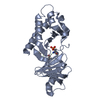 3rq7S C: citing same article ( S: Starting model for refinement |
|---|---|
| Similar structure data |
- Links
Links
- Assembly
Assembly
| Deposited unit | 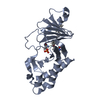
| ||||||||
|---|---|---|---|---|---|---|---|---|---|
| 1 |
| ||||||||
| Unit cell |
|
- Components
Components
| #1: Protein | Mass: 27285.158 Da / Num. of mol.: 1 / Fragment: Polo-box domain residues 371-603 Source method: isolated from a genetically manipulated source Source: (gene. exp.)  Homo sapiens (human) / Gene: PLK1, PLK / Production host: Homo sapiens (human) / Gene: PLK1, PLK / Production host:  |
|---|---|
| #2: Protein/peptide | Mass: 962.101 Da / Num. of mol.: 1 / Source method: obtained synthetically / Source: (synth.) synthetic construct (others) |
| #3: Water | ChemComp-HOH / |
-Experimental details
-Experiment
| Experiment | Method:  X-RAY DIFFRACTION / Number of used crystals: 1 X-RAY DIFFRACTION / Number of used crystals: 1 |
|---|
- Sample preparation
Sample preparation
| Crystal | Density Matthews: 2 Å3/Da / Density % sol: 38.56 % |
|---|---|
| Crystal grow | Temperature: 291 K / Method: vapor diffusion, hanging drop / pH: 8 Details: Frozen stocks of protein at 37 mg/mL in 10 mM TRIS pH8, 0.5 M NaCl, 10 mM DTT were thawed and diluted to 10 mg/ml with the same buffer. Complexes with each of three macrocycle compounds (3b, ...Details: Frozen stocks of protein at 37 mg/mL in 10 mM TRIS pH8, 0.5 M NaCl, 10 mM DTT were thawed and diluted to 10 mg/ml with the same buffer. Complexes with each of three macrocycle compounds (3b, 3c and 4b) were prepared by adding 100 mM stocks of the macrocycle in DMSO directly to the diluted protein to achieve a final concentration of 1 mM. Crystals were grown by hanging drop vapor diffusion, with drops made by mixing equal volumes of protein-macrocycle complex and well solution containing 2-6% PEG-3350. Crystals were cryo-protected by quickly dipping in a solution of 37.5% ethylene glycol in well solution and frozen in liquid nitrogen |
-Data collection
| Diffraction | Mean temperature: 100 K |
|---|---|
| Diffraction source | Source:  SYNCHROTRON / Site: SYNCHROTRON / Site:  APS APS  / Beamline: 24-ID-C / Wavelength: 0.9795 Å / Beamline: 24-ID-C / Wavelength: 0.9795 Å |
| Detector | Type: PSI PILATUS 6M / Detector: PIXEL / Date: Nov 30, 2013 |
| Radiation | Protocol: SINGLE WAVELENGTH / Monochromatic (M) / Laue (L): M / Scattering type: x-ray |
| Radiation wavelength | Wavelength: 0.9795 Å / Relative weight: 1 |
| Reflection | Resolution: 1.398→50 Å / Num. obs: 42019 / % possible obs: 98.4 % / Redundancy: 6.5 % / Rsym value: 0.064 / Net I/σ(I): 3.1 |
| Reflection shell | Resolution: 1.398→1.42 Å / Redundancy: 6.1 % / Rmerge(I) obs: 0.48 / Mean I/σ(I) obs: 1.5 / % possible all: 96.3 |
- Processing
Processing
| Software |
| |||||||||||||||||||||||||||||||||||||||||||||||||||||||||||||||||||||||||||||||||||||||||||||||||||||||||
|---|---|---|---|---|---|---|---|---|---|---|---|---|---|---|---|---|---|---|---|---|---|---|---|---|---|---|---|---|---|---|---|---|---|---|---|---|---|---|---|---|---|---|---|---|---|---|---|---|---|---|---|---|---|---|---|---|---|---|---|---|---|---|---|---|---|---|---|---|---|---|---|---|---|---|---|---|---|---|---|---|---|---|---|---|---|---|---|---|---|---|---|---|---|---|---|---|---|---|---|---|---|---|---|---|---|---|
| Refinement | Method to determine structure:  MOLECULAR REPLACEMENT MOLECULAR REPLACEMENTStarting model: 3RQ7 Resolution: 1.398→37.901 Å / SU ML: 0.13 / Cross valid method: FREE R-VALUE / σ(F): 1.35 / Phase error: 17.24 / Stereochemistry target values: ML
| |||||||||||||||||||||||||||||||||||||||||||||||||||||||||||||||||||||||||||||||||||||||||||||||||||||||||
| Solvent computation | Shrinkage radii: 0.9 Å / VDW probe radii: 1.11 Å / Solvent model: FLAT BULK SOLVENT MODEL | |||||||||||||||||||||||||||||||||||||||||||||||||||||||||||||||||||||||||||||||||||||||||||||||||||||||||
| Refinement step | Cycle: LAST / Resolution: 1.398→37.901 Å
| |||||||||||||||||||||||||||||||||||||||||||||||||||||||||||||||||||||||||||||||||||||||||||||||||||||||||
| Refine LS restraints |
| |||||||||||||||||||||||||||||||||||||||||||||||||||||||||||||||||||||||||||||||||||||||||||||||||||||||||
| LS refinement shell |
|
 Movie
Movie Controller
Controller


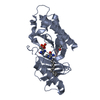
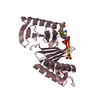

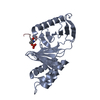

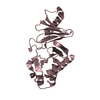
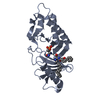
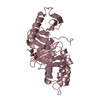
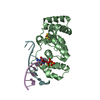
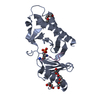



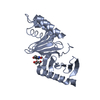
 PDBj
PDBj








